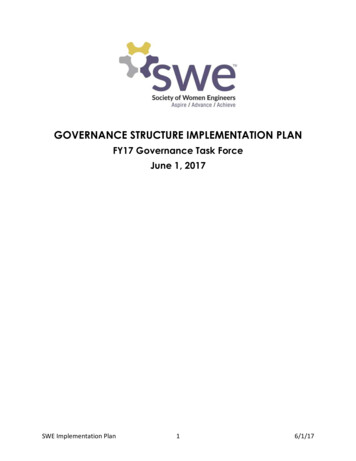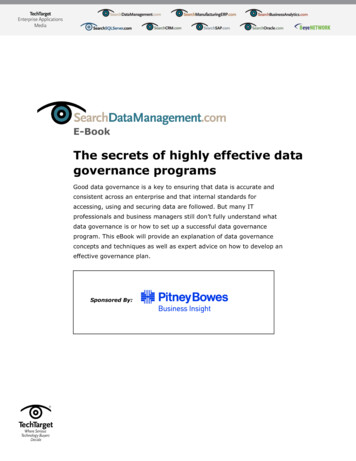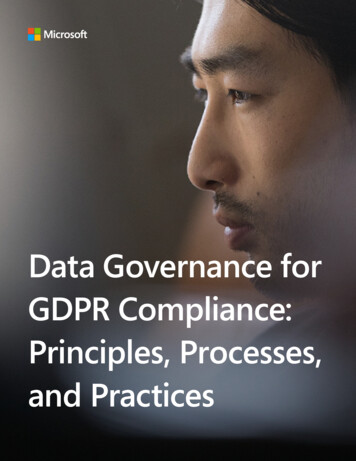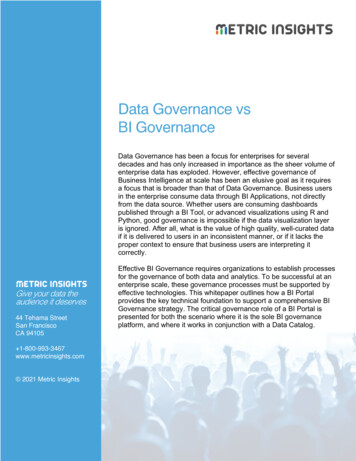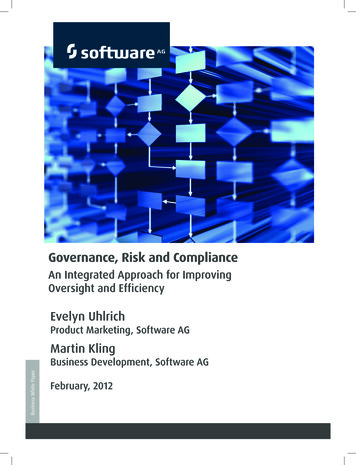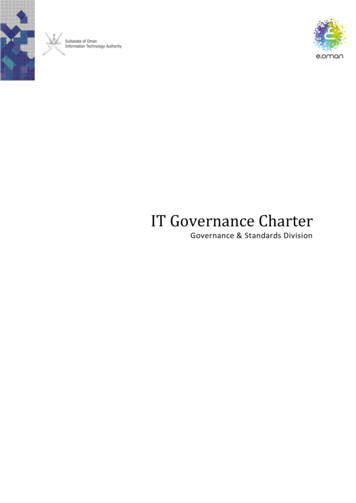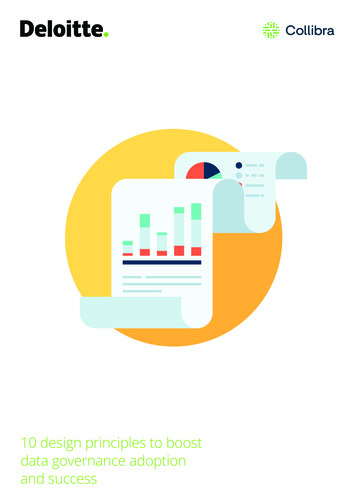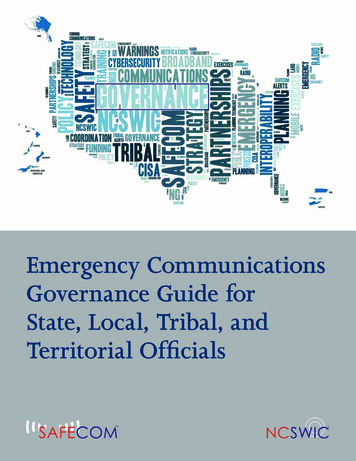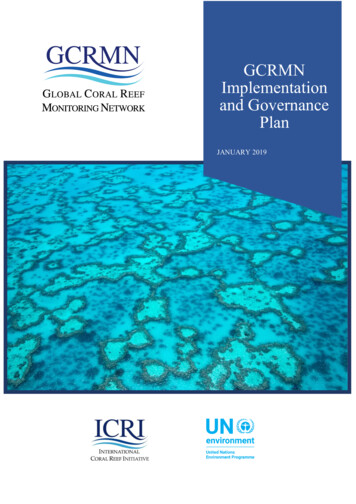
Transcription
GCRMNImplementationand GovernancePlanJANUARY 2019
GCRMN Implementation and Governance Plan. January 2019Page iGCRMN Implementation and Governance PlanJanuary 2019Adopted by ICRI members at the33rd General Meeting, 5-7 December 2018, MonacoCitation: GCRMN 2019. GCRMN Implementation and Governance Plan. International Coral ReefInitiative (ICRI). Available: https://www.gcrmn.net/about-gcrmn/igp/Cover photo: The Ocean Agency, onesia
GCRMN Implementation and Governance Plan. January 2019Page iiThe Global Coral Reef Monitoring Network (GCRMN) Implementation and Governance Plan wasprepared through a working group convened by the Secretariat of the International Coral Reef Initiative(ICRI) and the United Nations Environment Programme (UN Environment), pursuant to the resolutionon GCRMN adopted at ICRI General Meeting 31 and UN Environment Assembly Resolution 2/12 onSustainable Coral Reef Management.Working Group:Francis Staub, ICRI and Jerker Tamelander, UN Environment (working groupconvenors); Dr. David Obura, CORDIO East Africa (lead author), AmandaBrigdale (Great Barrier Reef Marine Park Authority (GBRMPA, Australia)),Chuck Cooper (Vulcan Inc. USA), Wilfrid Deri (Ministry of State, Monaco), HadiYoga Dewanto (Ministry of Marine Affairs and Fisheries, Republic ofIndonesia), Helen Fox (Vulcan Inc. USA), Akiko Hamada-Ano (South PacificRegional Environment Programme (SPREP)), Jane Hawkridge (Joint NatureConservation Commission (JNCC, UK) ), Kirsten Isensee (IntergovernmentalOceanographic Commission of UNESCO - Ocean Science Section), MargaretJohnson (Great Barrier Reef Marine Park Authority (GBRMPA, Australia)),Justine Kimball (NOAA Coral Reef Conservation Program, USA), TadashiKimura (Japan Wildlife Research Center (JWRC)), Lucie Labbouz (RegionalActivity Centre for Specially Protected Areas and Wildlife (SPAW-RAC) ), BenPalmer (Great Barrier Reef Marine Park Authority (GBRMPA, Australia)),Jason Philibotte (NOAA Coral Reef Conservation Program, USA), SergePlanes (Centre de Recherche Insulaire et Observatoire de l'Environnement(CRIOBE, France), Heidi Prislan (Department of Foreign Affairs and Trade,Australia), Manuel Gonzales Rivero (Australian Institute of Marine Science(AIMS)), Franz Paul Smith (Charles Darwin Foundation, Ecuador), DavidSouter (Australian Institute of Marine Science (AIMS)), Aurélie Thomassin(Ministry for Ecological and Solidary Transition, France), Karenne Tun(National Parks Board, Singapore).Suggested citation:ICRI and UN Environment 2019. Global Coral Reef Monitoring Network(GCRMN) Implementation and Governance Plan. 17pAcknowledgementsThe input and advice of the following individuals is gratefully acknowledged:Lucy Bastin (EU Joint Research Center, JRC), Roger Beeden (Great BarrierReef Marine Park Authority (GBRMPA), Australia), Claire Bissery (IFREMER,France), Pascale Chabanet (Institute for Research and Development (IRD),France), Andrew Chin (James Cook University, Australia), Guillermo DiazPullido (Griffith University, Australia), Pete Edwards (NOAA, USA), AndrewHoey (Australian Coral Reef Society Senior Research Fellow, ARC Centre ofExcellence), Eduardo Klein (Ocean Biogeographic Information System, OBIS),Petra Lundgren (Great Barrier Reef Foundation, GBRF), Cate McElroy(Department of the Environment and Energy, Australia), Fiona Merida (GreatBarrier Reef Marine Park Authority (GBRMPA), Australia), Patricio Miloslavich(UNESCO-IOC, GOOS Biology and Ecosytems Panel), Erin Peterson(Queensland University of Technology, Australia), Melita Samoilys (CORDIOEast Africa), Jennifer Smith (UC San Diego, USA), Mahani Taylor (Departmentof the Environment and Energy, Australia), Hazel Thornton (UNEP-WorldConservation Monitoring Center), Lauren Weatherdon (UNEP-WorldConservation Monitoring Center), Liz Wren (Great Barrier Reef Marine ParkAuthority (GBRMPA), Australia).Financial support towards development of the GCRMN Implementation and Governance Plan wasprovided by the governments of France, Sweden and United States of America.International Coral Reef Initiative: The International Coral Reef Initiative (ICRI) is an informalpartnership between nations and organizations which strives to preserve coral reefs and relatedecosystems around the world.www.icriforum.org
GCRMN Implementation and Governance Plan. January 2019Page iiiGlobal Coral Reef Monitoring Network: The Global Coral Reef Monitoring Network (GCRMN)supports ICRI by working through a global network to strengthen the provision of best available scientificinformation on, and communication of, the status and trends of coral reef ecosystems, for theirconservation and management.www.gcrmn.orgUnited Nations Environment Programme: The United Nations Environment Programme (UNEnvironment) is the leading global environmental authority that sets the global environmental agenda,promotes the coherent implementation of the environmental dimension of sustainable developmentwithin the United Nations system, and serves as an authoritative advocate for the global environment.www.unenvironment.org
GCRMN Implementation and Governance Plan. January 2019Page ivExecutive summaryThe Global Coral Reef Monitoring Network (GCRMN) has operated as the de facto global coral reefobserving system since 1999, aggregating data from local levels to national, regional and global, andgenerating influential global and regional reports. It has played a strong role in building local andnational capacity in coral reef reporting, to improve actions to sustain coral reefs in response to prioritiesset across all these levels. The development of this Implementation and Governance Plan (IGP) wasmandated by a decision adopted at the 31st International Coral Reef Initiative (ICRI) General Meeting,in December 2016, and the IGP was adopted at the 33rd ICRI General Meeting in December 2018. TheIGP strengthens GCRMN in tracking and reporting on coral reef status and trends, in keeping withcurrent efforts to improve global observing networks of biodiversity and ocean systems. It enhancesGCRMN’s relevance in addressing key societal priorities to sustain reefs and the benefits they provideto people adopted at the global level, including the 2030 Agenda for Sustainable Development and theemerging post-2020 biodiversity framework, and tracking of progress in relation to these.GCRMN has four goals, to: 1) improve understanding of coral reef status and trends, globally andregionally; 2) analyse and communicate coral reef biophysical, social and economic trends, providingscience-based recommendations in support of raising awareness, management and policydevelopment; 3) enable and facilitate greater utilization of coral reef data, including in research; and 4)build human and technical capacity to collect, analyse and report biophysical and socio-economic dataon coral reefs.GCRMN aggregates coral reef data provided by contributors and generates higher level reporting onreef status and trends. Decades of experience have identified hard coral cover and composition, fleshyalgae and fish community structure as essential variables for describing reef health and futureprospects, along with varied contextual information that includes socio-economic benefit and pressureinteractions, environmental variables, and other ecological and functional variables (such as coralrecruitment, coral bleaching, etc.). This IGP defines these key variables and identifies three qualitylevels at which data for these variables can be submitted. This data quality approach enables andfacilitates aggregation of data from different sources, and also provides clear steps for capacity buildingto improve the data quality provided by contributors of all levels, and for use in decision-making atmultiple levels.The primary outputs of GCRMN are regional, global and thematic reports on coral reef status andtrends, supported by online databases allowing for data curation and enhanced data access for a widerange of stakeholders. To the extent possible, GCRMN works towards open access to data in order toamplify its use in coral reef research, conservation, and relevant planning processes.GCRMN is governed by a Steering Committee that derives its mandate from the ICRI General Meeting.The Steering Committee provides high level oversight, guidance, advocates for the GCRMN and helpssecure support and resources. Implementation of the GCRMN is led by a Global Coordinator supportedby a host institution, in close partnership with Regional Coordinators, time-bound Task Forcesmandated by the Steering Committee, and relevant technical experts. The GCRMN Regional Networks,each with a Regional Coordinator, are the primary structures within the GCRMN, and bring togethernational networks, relevant institutions and ad hoc contributors of data. Key partners and supporters tothe GCRMN include other international and inter-governmental bodies and entities with relevantmandates and expertise that support coral reef monitoring. Participation in the GCRMN is voluntary,based on shared goals contained in this IGP.This Implementation and Governance Plan became operational in January 2019. To ensure the IGPremains fit for purpose it will be reviewed and revised periodically, including at least in 2025 and 2030,corresponding to milestones of the Sustainable Development Goals and the post-2020 biodiversityframework.
GCRMN Implementation and Governance Plan. January 2019Page vContentsExecutive summary . iv1.1.1.2.Introduction . 1Background .1Why is GCRMN needed? . 12.1.Importance of coral reefs .12.2.Societal justification for monitoring coral reefs .2Local and national importance .2Global and regional and importance.23.System design of GCRMN . 33.1.Goals of GCRMN .4Goal 1. Improve understanding of coral reef status and trends, globally and regionally .4Goal 2. Analyse and communicate coral reef biophysical, social and economic trends, providingscience-based recommendations in support of raising awareness, management and policydevelopment. .4Goal 3. Enable and facilitate greater utilization of coral reef data, including in research. .4Goal 4. Build human and technical capacity to collect, analyse and report biophysical and socioeconomic data on coral reefs. .53.2.Outputs - what the GCRMN produces .5Regional, global and thematic reports .5Management/decision support reports .5Data management and accessibility .64.Governance . 64.1.Who makes up the GCRMN .64.2.GCRMN as an ICRI Network .64.3.Steering Committee .6Task forces .74.4.Global Coordination and Institutional hosting .74.5.Regional coordination .8National networks .94.6.Related networks .95.5.1.5.2.5.3.5.4.5.5.Implementing the GCRMN . 9Ecological variables .9Socio-economic variables and integrated monitoring .10Data quality .11Sharing and aggregating data .11Capacity building .126.The future of the GCRMN – a vision for 2030 . 127.Appendices . 137.1.7.2.7.3.Annex I. Acronyms .13Annex II. GCRMN publications .13Annex III - References cited .14
GCRMN Implementation and Governance PlanPage 11. Introduction1.1. BackgroundThe International Coral Reef Initiative (ICRI) is an informal partnership among countries, organizationsand intergovernmental bodies, founded in 1994. ICRI's members came together to address thechallenges faced by tropical coral reefs, because of their biodiversity and the benefits derived from themto adjacent and dependent communities and countries. Cold water coral ecosystems and ecosystemsassociated with coral reefs (i.e. mangroves and seagrasses) also fall within ICRI's mandate(www.icriforum.org), but this document focuses on monitoring of tropical coral reefs.The Global Coral Reef Monitoring Network (GCRMN) was established by ICRI in 1995, initially with theprimary task of reporting on the condition of the world’s coral reefs in the context of development of theICRI Call to Action. GCRMN produced global reports using a consistent approach between 1999 and2008, and also published a number of thematic reports (Annex II). Now, multiple assessment andreporting processes from national to global levels (see section 2) require robust data and providing acommon and consistent source for them is necessary.The ICRI General Meeting in 2014 defined GCRMN's main purpose as follows: "GCRMN supports ICRIby working through a global network to strengthen the provision of best available scientific informationon, and communication of, the status and trends of coral reef ecosystems, for their conservation andmanagement". The ultimate aim of GCRMN is to support delivery of positive outcomes for coral reefsand dependent people and sectors by informing policy and management processes at global, regionaland local levels. The development of this Implementation and Governance Plan was mandated by adecision at the 31st ICRI General Meeting, and the plan was adopted at the 33rd ICRI General Meetingin December 2018.The GCRMN has operated as the de facto global coral reef observing system since 1999, generatinginfluential global and regional reports. Since monitoring programs are generally developed to addresslocal needs, a key role for the GCRMN is to provide guidance on data standards and approaches thatmaximize data quality at this level and facilitate aggregating data to larger scales. Through this, thevalue of the data is increased through sharing, contextualization with other data and contributing tomultiple policy processes. The global scope of coral reefs means a common global framework formonitoring is needed to provide the necessary understanding of the state of coral reefs at a globalscale.The increasing need for data on earth systems, combined with increasing capability for generating,managing and using global datasets, has promoted growth of global monitoring of terrestrial,atmospheric and ocean systems. Working groups under the Global Ocean Observing System (GOOS)(Miloslavich et al. 2017) and the Group on Earth Observations Biodiversity Observation Network(GEOBON) (Muller-Karger et al 2018) are charged with bringing this experience to support the growthof global observing systems for ocean and marine biodiversity, including coral reefs.2. Why is GCRMN needed?2.1. Importance of coral reefsCoral reefs are exceptionally biodiverse and productive. Ringing tropical coastlines, they play a uniquerole in the lives of coastal people and countries and are an immensely valuable asset from local tonational levels (Wilkinson 2004, Burke et al. 2011, Beck et al. 2018). Coral reefs are the most speciesrich marine ecosystem and play a role in the life cycle of one quarter of all marine fish species (Burkeet al. 2008). Their productivity supports the livelihoods and food security of more than half a billionpeople in more than 100 countries, particularly Small Island Developing States (SIDS), and they are atrillion-dollar economic asset (Hoegh-Guldberg et al. 2015).Coral reefs are also under significant direct pressure from human activities including fishing, pollution,recreation, transport and coastal development, and are uniquely vulnerable to ocean warming andacidification. This puts the ecological, social, and economic benefits they provide in danger, especially
GCRMN Implementation and Governance PlanPage 2as countries are intensifying their demands on ocean resources to deliver 'blue growth' and economicdevelopment.Because of this, coral reefs are sensitive indicators of coastal ocean health, and particularly so forclimate change and ocean acidification impacts, with implications for society and sustainabledevelopment (IPCC 2018). They have a prominent role from local to global levels as a flagship socioecological system, showing the state of nature, of peoples' dependency on ecosystem services, and ofthe ability of governance systems to both optimize and safeguard nature's benefits for current and futuregenerations. The need for accurate data and information to inform decisions that promote sustainabledevelopment is increasing, and only increases the need for GCRMN and its outputs.2.2. Societal justification for monitoring coral reefsLocal and national importanceAt local levels, coral reefs are the foundation for integrated ecological, social and economic systems.Where people have lived and depended on reefs for generations, many have developed cultural andsocial practices and norms reflecting this dependence, and the vulnerability of reef and coastal systems.Modern coastal economies are equally dependent on reef ecosystem services, though this dependenceis only recently being acknowledged and is often not built into sustainability practices. Monitoring ofcoral reefs can provide critical data, including of indigenous and local knowledge, that helps coastalresidents and authorities understand the health of the reef, their dependence on its health, and theeconomic and financial consequences of reef decline. Thus, the societal need and justification for coralreef monitoring at local levels is high and requires design of monitoring systems to address localdynamics, key threats and socio-economic dimensions.Design of local monitoring programmes should respond to local needs. GCRMN does not directlyaddress design of local monitoring, but a key goal of GCRMN is to ensure that monitoring is globallyconsistent while being responsive to the local context. GCRMN will also promote an IntegratedMonitoring approach at local levels (combining biophysical and socio-economic components) that istied into local governance and adaptive management mechanisms (building on efforts underway e.g.in the Caribbean (UNEP/SPAW 2017)).Global and regional and importanceMaintaining the status and health of nature is written into the goals and targets of multiple global andregional agreements. Reporting on the health of coral reefs is specifically called for in or particularlyrelevant to many of them:Agenda 2030 of the United Nations General Assembly identified 17 Sustainable DevelopmentGoals, of which SDG14, to "Conserve and sustainably use oceans, seas and marine resources" focuseson the ocean. For three of the ten targets within SDG14, coral reefs are particularly relevant and canbe a flagship system:14.2 - By 2020, sustainably manage and protect marine and coastal ecosystems to avoid significantadverse impacts, including by strengthening their resilience, and take action for their restoration inorder to achieve healthy and productive oceans;14.5 - By 2020, conserve at least 10 per cent of coastal and marine areas, consistent with national andinternational law and based on the best available scientific information; and14.7 - By 2030, increase the economic benefits to small island developing States and least developedcountries from the sustainable use of marine resources, including through sustainable managementof fisheries, aquaculture and tourism.Similarly, the benefits provided by coral reefs to people are embedded in other SDG targets (e.g.economic and social benefits, governance, planning, knowledge transfer and research) so socioeconomic and integrated monitoring of coral reefs can help assess achievement of the SDGs for coralreef countries.Convention on Biological Diversity (CBD) - coral reefs are a flagship ecosystem for Aichi Target 10,and the focus of Decision XII/23.1 GCRMN will provide the core indicators to be used by countries to1 Priority Actions to Achieve Aichi Biodiversity Target 10 for Coral Reefs and Closely Associated Ecosystems) was adopted inPyeongchang, Democratic Republic of Korea, in October 2014
GCRMN Implementation and Governance PlanPage 3attribute and reduce multiple stressors causing reef decline and to inform and monitor the post-2020targets.UN Framework Convention on Climate Change (UNFCCC) - coral reefs, with polar systems, are aflagship ecosystem for achieving the Paris Agreement and can provide a sensitive indicator of theconsequences of warming above 1.5 C. Coral reefs are also included in Nationally DeterminedContributions (NDCs) and National Adaptation Plans of Action of some State Parties, so credible datafor monitoring progress is needed.United Nations Environment Assembly (UNEA) - in Resolution 2/12 on coral reefs2, UN memberstates called on UN Environment to “support further development of coral reef indicators, regional coralreef assessments, and preparation of a global report through GCRMN”.Regional agreements - the importance of coral reefs is highlighted in tropical Regional SeasConventions and Action Plans (e.g. Cartagena Convention in the Caribbean), relevant Large MarineEcosystems (e.g. the Agulhas-Somali Current LME), and in regional economic blocs (e.g. the AsiaPacific Economic Community (APEC)) and others. Providing core indicators on coral reef health andsocio-economic benefits for these regional instruments will help countries report on their obligationsand develop regional strategies for coral reef protection.Assessment processes – that require coral reef data include the UN Regular Process for the WorldOcean Assessment, the Intergovernmental Panel on Climate Change (IPCC) and theIntergovernmental Science-Policy Platform on Biodiversity and Ecosystem Services (IPBES)assessments. There are also regional assessment processes such as the State of Marine Ecosystemsand shared Living Marine Resource in the Wider Caribbean (Gulf of Mexico and CLME Region) underthe UN Environment Programme/Caribbean Environment Programme (UNEP/CEP) that are focusedon coral reefs and associated ecosystems.3. System design of GCRMNThree key design elements for an ocean observing network responding to societal priorities have beendefined (UNESCO 2012): justification or goals for the observing system in relation to societal priorities; processes defining what data is collected, how and by whom; outputs, being syntheses of the observations to inform decisions based on the societal priorities.2UN Environment Assembly resolution 2/12 on Sustainable Coral Reefs Management
GCRMN Implementation and Governance PlanDriversPressuresBenefitsStatus andtrendsGoal 2ResponsesGoal 1The Drivers Pressures Status ImpactResponses (DPSIR) model is often used toevaluate human impacts and mitigation of theseimpacts (Patricio et al. 2016, Miloslavich et al.2018). More holistic interpretations of the modelhave been developed, incorporating aspects ofecosystem-based management and socioecological systems (Kittinger et al. 2012, Kelbleet al. 2013, Wongbusarakum et al. 2014), andto facilitate adaptive management responses topressures, trends and capabilities (fig. 1). Thisis useful for the GCRMN to ensure that:a) the goals for monitoring relate tosustainability of the reef social-ecologicalsystem as a whole;b) monitoring variables are focused on keyPressures, Status and Trends, as well asBenefits; andc) outputs are targeted to support Responses,which may directly or indirectly address anyparts of the model.Page 4Goal 3, Goal 4Fig. 1. A holistic interpretation of the Driver Pressure StateImpact Response (DPSIR) model that incorporatesecosystem-based and adaptive management principles toidentify priority questions, variables and responses for anobserving system. Monitoring focuses on status and trends,plus key pressure and benefit variables, and is used toinform management and policy responses in relation tothese, and overarching drivers.3.1. Goals of GCRMNGCRMN has three primary goals, with capacity building as a fourth, overarching priority. Specificobjectives are identified under each goal:Goal 1. Improve understanding of coral reef status and trends, globally and regionallyObjectives1.1 Quantify change in core components of the reef community1.2 Attribute changes and impacts on coral reefs to key drivers1.3 Identify and interpret reef recovery processes important for maintaining and restoring reefs1.4 identify and interpret trends in key social and economic drivers and benefits in relation to coral reefstatus and trends.Goal 1 sets the principal data requirements of the GCRMN. The objectives progress in complexity,whereby 1.1. defines the minimum measures necessary to quantify change reliably; 1.2 enablesattribution of change to drivers; 1.3 enables interpretation of recovery processes and actions; and 1.4assesses social, economic and natural changes in a more integrated whole.Goal 2. Analyse and communicate coral reef biophysical, social and economic trends, providing science-basedrecommendations in support of raising awareness, management and policy development.Objectives2.1 Support evidence-based decisions on management and policy responses to coral reef biophysical,social and economic trends.2.2 Support assessments and reporting that track progress towards internationally adopted goals andtargets, in relation to environmental, social and economic targets.Goal 2 addresses GCRMN products in support of (adaptive) management and policy action (2.1), andaggregated reporting in ways relevant for tracking delivery of internationally adopted goals and targets(2.2). Tools to deliver on these objectives include the regional and global reports, and other decisionsupport tools targeting adaptive management, policy and varied stakeholder audiences.Goal 3. Enable and facilitate greater utilization of coral reef data, including in research.Objectives3.1 Support and promote exchange of information and sharing of knowledge about reef status, trendsand responses.
GCRMN Implementation and Governance PlanPage 53.2 Contribute to and operationalize innovations and their application in coral reef monitoring, researchand modelling.Goal 3 addresses managing, securing and making data accessible on open platforms (3.1) andadopting technical innovations that are changing by orders of magnitude the type and availability ofdata on coral reef systems (3.2).Goal 4. Build human and technical capacity to collect, analyse and report biophysical and socio-economic dataon coral reefs.Objectives4.1 Identify capacity building needs at local, national and regional levels, and support the networkmembers in meeting these needs.4.2Generate and report on relevant metrics demonstrating delivery of GCRMN goals 1, 2 and 3.Building human and technical capacity is an important function of GCRMN, both as a network ofcontributors/partners and as a technical body. The capacity building approach seeks to a) maximizedata submission to the GCRMN, to cover as much reef area as possible regionally and globally, fromas broad a range of stakeholders as possible; and b) provide an in-built evalu
GCRMN Implementation and Governance Plan. January 2019 Page iv Executive summary The Global Coral Reef Monitoring Network (GCRMN) has operated as the de facto global coral reef observing system since 1999, aggregating data from local levels to national, regional and global, and generating influential global and regional reports.
